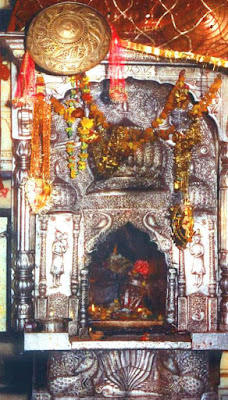Jwalamukhi Temple, Himachal Pardesh
Jwalamukhi, the deity of Flaming Mouth. Jwalamukhi is a famous temple of Goddess Jwalamukhi, the deity of flaming mouth, believed to be the appearance of the Goddess Sati. The Devi appears in the form of nine different flames means nine different forms of Maa Durga.
The Legend of Jwalamukhi Temple
There are many legends relating to Jwalamukhi temple.
According to a legend that Prajapati Daksha, the father of Sati once organized a great Yajna and invited all gods except Shiva. When Sati came to know of this, she requested Shiva to go to Yajna. Shiva maintained that they should not go uninvited. Sati argued that it was not bad to go to parents or Gurus un-invited. Shiva did not agree for himself but allowed Sati to go. On reaching her father's house, Sati saw that no seat (assan) had been earmarked for Shiva, which meant a deliberate attempt to humiliate Shiva. She was so offended that she at once plunged herself into the havankund of Yajna. On hearing this, Shiva rushed to the spot and found Sati half burnt. Distressed Shiva carried the remains of Sati, gyrated it from summit to summit. Apprehending a great calamity befalling, the gods ran to Lord Vishnu for help who then severed Sati's body into pieces with his Sudarshan Chakra. Places where the pieces fell, gave rise to fifty-one Shaktipeeths, the centres where the power of goddess is inherit.
There is another legend associated with Jawalamikhi. A cowherd found that one of his cows was always without milk. He followed the cow to find out the cause. He saw a girl coming out of the forest, drank the cow's milk, and then disappeared in a flash of light. The cowherd went to the king and told him the story. The king was aware of the legend that Sati's tongue had fallen in this area. The king tried, without success, to find that sacred spot. Again, some years later, the cowherd went to the king to report that he had seen a flame burning in the mountains. The king found the spot and had darshan (vision) of the holy flame. He built a temple there and arranged for priests to engage in regular worship.
The History of Jwalamukhi Temple
The history of the Jwalamukhi Temple states that the great Mughal emperor Akbar visited it and tried to douse of the flame of the temple. However, when unsuccessful, he willingly submitted to the power of the goddess. He presented a gold chhatri (umbrella) for the goddess which is said to have turned into copper when he turned around to have a look at it before leaving. Maharaja Ranjit Sigh also paid a visit to the temple in the year 1809. His son, Kharak Singh gifted a pair of silver plated folding doors to the temple while Ranjit Singh himself gave the gilt roof.
Structure of Jwalamukhi temple
The temple of Jwalamukhi is not an architectural delight. Moreover, there is no idol to worship too. The building has a gilt dome and a silver plated folding doors. Inside, there is a 3 feet square pit with pathway all around. In the centre, there is a hollowed rock over a primary fissure of flame. This one is regarded as the mouth of the Mahakali. Flames emit out from several other point in the pit. They are nine in total and represent the different form of the goddess - Saraswati, Annapurna, Chandi, Hing Laj, Vindhya Vasini, Mahalakshmi, Mahakali, Ambika and Anjana. There are two lions in front of the temple.
Rituals performed in Jwalamukhi temple
During the entire day, there are in total five aartis conducted in the temple. The first aarti is performed early in the morning at around 5 am and is known as the Mangal aarti. The next aarti is carried out at the time of sunrise and is called Panjupchaar Pujan. At around midnoon, it is time for yet another aarti, Bhog Ki Aarti. The evening aarti at around 7 pm is simply called aarti while the last one at around 10 pm is known as the Shaiyan ki aarti.
The last aarti at the Jwalamukhi Temple is particularly unique since it is only here that such an aarti is conducted. During the aarti, the bed of the goddess is decorated with beautiful dresses and jewelleries. The aarti is performed in two parts. The first one is in the main temple while the second one is performed in the sejabhavan. Slokas from 'Sondarya Lahri' by Shri Shakracharya are recited throughout the aarti.
Havan is also performed once a day and parts of Durga Saptarshi are recited during it. Offerings made before the goddess in puja include bhog of rabri or thickened milk, misri or candy, seasonal fruits and milk.
Fairs and festivals
The Jwalamukhi fair is held twice a year during the Navratri of Chaitra and Aswin. The devotees go round the 'Jwala Kund' in which the sacred fire burns, making their offerings. People come with red silken flags (dhwaja) to greet the Mother Goddess.
How to reach there
The closest airport is at Gaggal which is around 50 km away. The nearest railhead is a narrow gauge one at Ranital, 20 km away. Chandigarh airport and railway station is at a distance of around 200 km. The temple is also well connected by road. State transport buses from cities of Punjab and Haryana are available. Taxis are also there to take you to the Jwalamukhi temple.











No comments